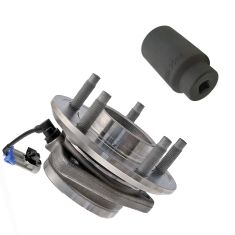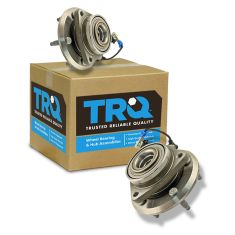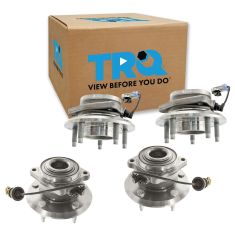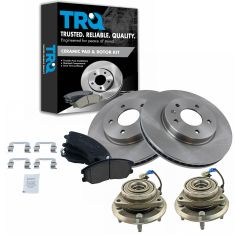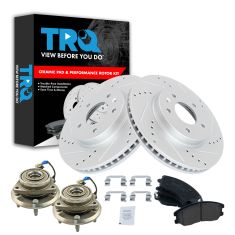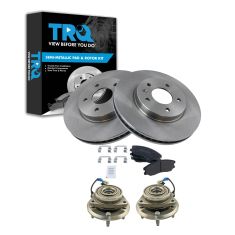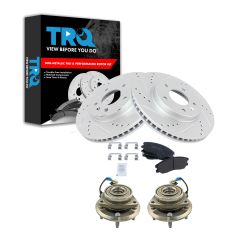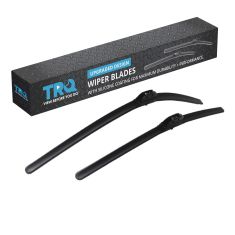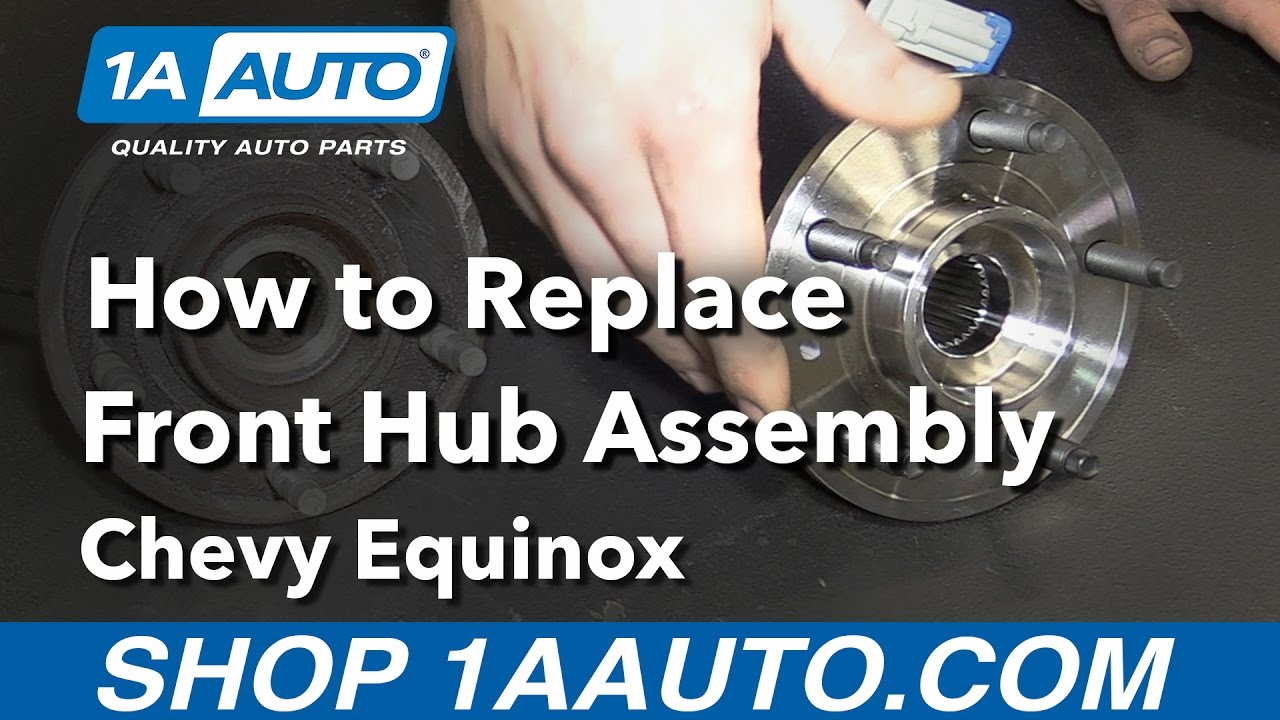Hi, I'm Mike from 1AAuto. We've been selling auto parts for over 30 years! We're dedicated to delivering quality auto parts, expert customer service, and fast and free shipping, all backed by our 100% satisfaction guarantee. So visit us at 1AAuto.com, your trusted source for quality auto parts.
In this video, we're going to be working with our 2008 Chevy Equinox. We're going to show you how to remove and replace your front wheel hub and bearing assembly. Ours comes with a new ABS sensor so we'll be changing that out as part of the assembly as well.
If you like this video, please click subscribe. We have a ton more information on this and many other vehicles. If you need this part for your car, you can follow the link down in the description over to 1AAuto.com.
Here are the items you'll need for this repair: full metric set, ratchet, socket extensions, full wrench metric set, T13 Torx screwdriver, 35mm socket, torque wrench, ½ inch breaker bar, flat punch, hammer, wire brush, brake grease, rust penetrant, bungee cords, jack, jack stands
Using a 19mm socket and a breaker bar, break all of your lug nuts loose about one turn to make it easy to get them off once our vehicle is in the air. Raise and support your vehicle. We're using a lift to make it easier to show you what's going on, but this job can easily be done in your driveway or garage at home on a jack and jack stands. Finish removing your lug nuts and remove the wheel and tire from the vehicle.
Now we're going to show you a cool trick that works for both removing rotor screws and axle nuts. Sometimes you can get these axle nuts with the wheel on. You pop the center cap off, you put the socket in there, and do it with the weight of the car on so you can't move it when you're breaking this loose. However, this particular vehicle's center cap is smaller than the socket we need to take that off, so we're going to take a wrench, doesn't matter what size. I'm using a 16mm. Place it over a wheel stud with the wrench angle going in toward the vehicle. I'm going to put one lug nut on all the way by hand to protect the threads. Lay the wrench on it. I'm going to use this lug nut to center the back of the wrench. Now we'll rotate it, jam it into the caliper and that's not going anywhere.
We'll remove our rotor screw with a T30 Torx socket, and I like to use a little breaker bar for this, just because once we get it loose, you can use it like a screwdriver. Comes off a lot quicker. This will also work with a ratchet. We'll use a 35mm socket on our axle nut and our breaker bar. Now you just grab the top of the wrench, turn it back around, remove your wheel lugs, and you can take that wrench off. If you set those wheel nuts up the way I showed you there, you'll see that it doesn't damage any of the threads in the process, which is very important. Now we'll use a big flat punch, put it into this little divot in the middle of the axle. You just want to tap that with a hammer until it starts bouncing like that. That means we have it backed all the way out and that it's free from the studs and our wheel bearing.
Remove the two 18mm bolts securing your caliper bracket onto the spindle. We're going to remove the caliper and bracket as an assembly to minimize the amount of tear-down and reassembly in this process. We'll do this using an 18mm socket and ratchet. These do have a little bit of torque on them, but you should be able to break them loose just fine. When you remove the last caliper bolt, we'll slide everything up and off and secure it up out of the way with either mechanic's wire, some strong zip ties, or I like to use a bungee cord. Then we'll remove the rotor.
Spray some penetrating oil on the back of the studs for your wheel bearing. You'll see where they come through right behind the hub, and then I like to try to spray all around the edges, too, to kind of let it soak in and free up the hub itself from the spindle because this is a steel hub and an aluminum spindle. Dissimilar metals tend to seize together pretty well. Now we'll take and clean off the threads that are exposed here on the back of the hub. Just use a steel wire brush. You don't have to go crazy, but there's a good bit of corrosion on here, and anything we remove now will just make it easier to go through the threads later. You want to do that to all three.
Disconnect the connector for the ABS sensor. Push down and release this from its retainer, the backing plate. Now we'll remove the 15mm bolts securing the hub into the spindle from the back side with a deep socket and a ratchet. We're going to go nice and slow and easy with these. If you break them, it's a lot harder to remove the hub although once you get it out, as long as you have some new bolts, you can use those to secure the new hub. Now we want to be very careful of the backing plate here because these are just sheet metal and if you bend them, they're going to drag against the back of the rotor and make some noise, so we'll hit the back of the hub and try to knock this out of the spindle. Once you get it out a good ways, if it's still being stubborn, you can take a chisel or a striking pry bar like this, try to help wedge it out. Once you have it out, you may need to just gently tap end of the axle just to release it. Remove the sensor wire from the backing plate, place this somewhere safe.
Here we have our old wheel bearing and hub assembly that we removed from our vehicle and our new part from 1AAuto.com. As you can see, we have the same hub face. We have a nice little threaded hole for our rotor screw. We have five brand new wheel studs with the same bolt pattern and threads, so we can obviously bolt up our original wheels and reuse the factory wheel lugs. We have the same center bore, which will keep our wheel on there nice and straight. The same three bolt flange on the rear, as well as same bore of the bearing itself where it'll sit into the spindle. These holes already come nicely tapped and threaded. It even comes with a nice new ABS sensor because these are very prone to breaking off in the hub, so we don't have to worry about that extra headache and step when removing and replacing our part. Now if your wheel bearing has gone bad, it'll create a grinding sound more noticeable when turning and putting load on that particular bearing, so a new part from 1A Auto has a nice tight new bearing in there. You may even notice a little bit of up and down and side to side play if you were to grab the wheel and check for a bad wheel bearing. This part will go in direct fit just like our original equipment, fix you up right.
Now we'll take a wire brush and just clean off this hub surface to remove as much of the buildup and debris as we can; make sure that our new bearing sits in nice and smooth and straight, and seats in fully without putting too much force on it. Be sure to wear proper safety equipment like a dust mask and some safety goggles when doing this so you don't get all that debris in your eyes and mouth. Now we'll put some grease on the inside of the board here to make sure our bearing and hub assembly goes in smoothly, as well as trying to help prevent it from seizing in there in the future, should we ever have to remove or change it again. Send the ABS sensor back through your backing plate, line up your wheel bearing, make sure that this sensor isn't somewhere it's going to get pinched. Reconnect the retainer to the ABS sensor. Just snaps in.
Slide the hub and bearing assembly back onto the splines of the axle shaft, and then I like to leave these out a little way. Make sure your backing plate's lined up as well. I like to leave them out a little ways to make it easier to see how I'm lining the bolt up. If I don't push this in all the way yet, you can spin that rear flange and help line it all up. Tighten up the three bolts using your 15mm deep socket and ratchet again. You want to try and tighten these down pretty evenly because some of that buildup may be holding up certain parts of the bearing. We'll go around and get a few turns on each bolt, and then move to the next one. Just keep going around in a circle to make sure our bearing goes in nice, and straight, and smooth. Torque all of your wheel bearing hub bolts to 96 foot-pounds.
Reconnect your ABS sensor. Apply a thin coat of brake grease to the surface of your new hub to prevent the rotor from seizing onto it later. Make sure you get the center board here too. Reinstall your rotor, being sure to put that beveled hole over the threaded hole for your rotor screw, which we'll reinstall now. We'll get it started by hand and finish tightening it down with our T-30 Torx bit.
Remove your bungee cord or whatever you used to secure your caliper carrier out of the way. Reinstall the caliper carrier and start your two 18mm bolts by hand. Tighten the bolts down with your 18mm socket and ratchet. Torque the caliper bracket bolts to 137 foot-pounds. Set up your wrench the same way we did to loosen the lug nut, but on the opposite side of the caliper this time, so we have something to hold it while we torque.
Reinstall your axle nut. We'll get it down all the way tight with your 35mm socket breaker bar, then we'll torque it to 151 foot-pounds. Move your wrench setup. Remove the wheel lugs. Reinstall your wheel and tire. Get all of your lug nuts on as tight as you can by hand. Lower the weight of your vehicle back onto the tires. With the partial weight of your vehicle back on the tires, tighten up your lug nuts to 100 foot-pounds in a cross pattern.
Thanks for watching. Visit us at 1AAuto.com for quality auto parts, fast and free shipping, and the best customer service in the industry.


